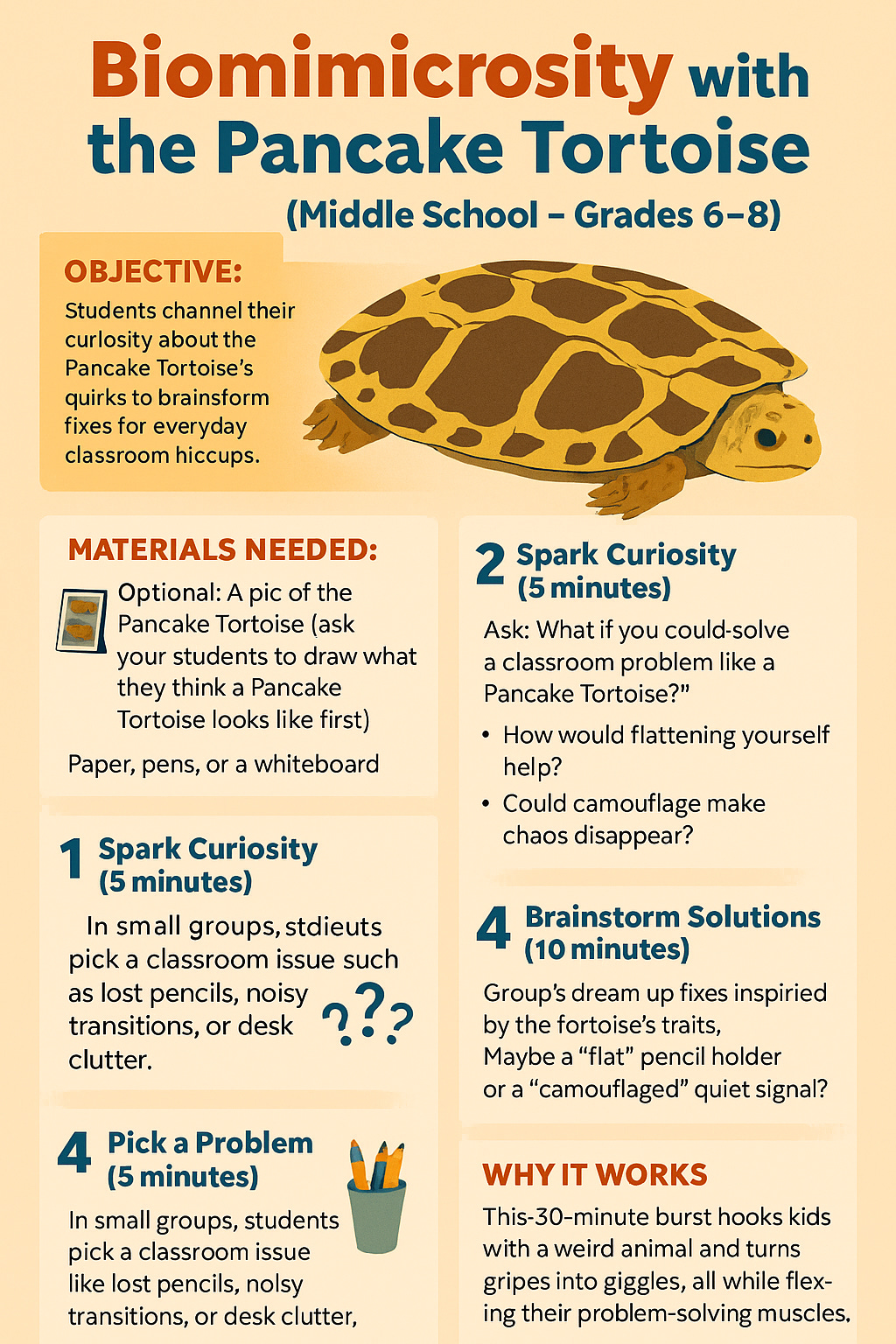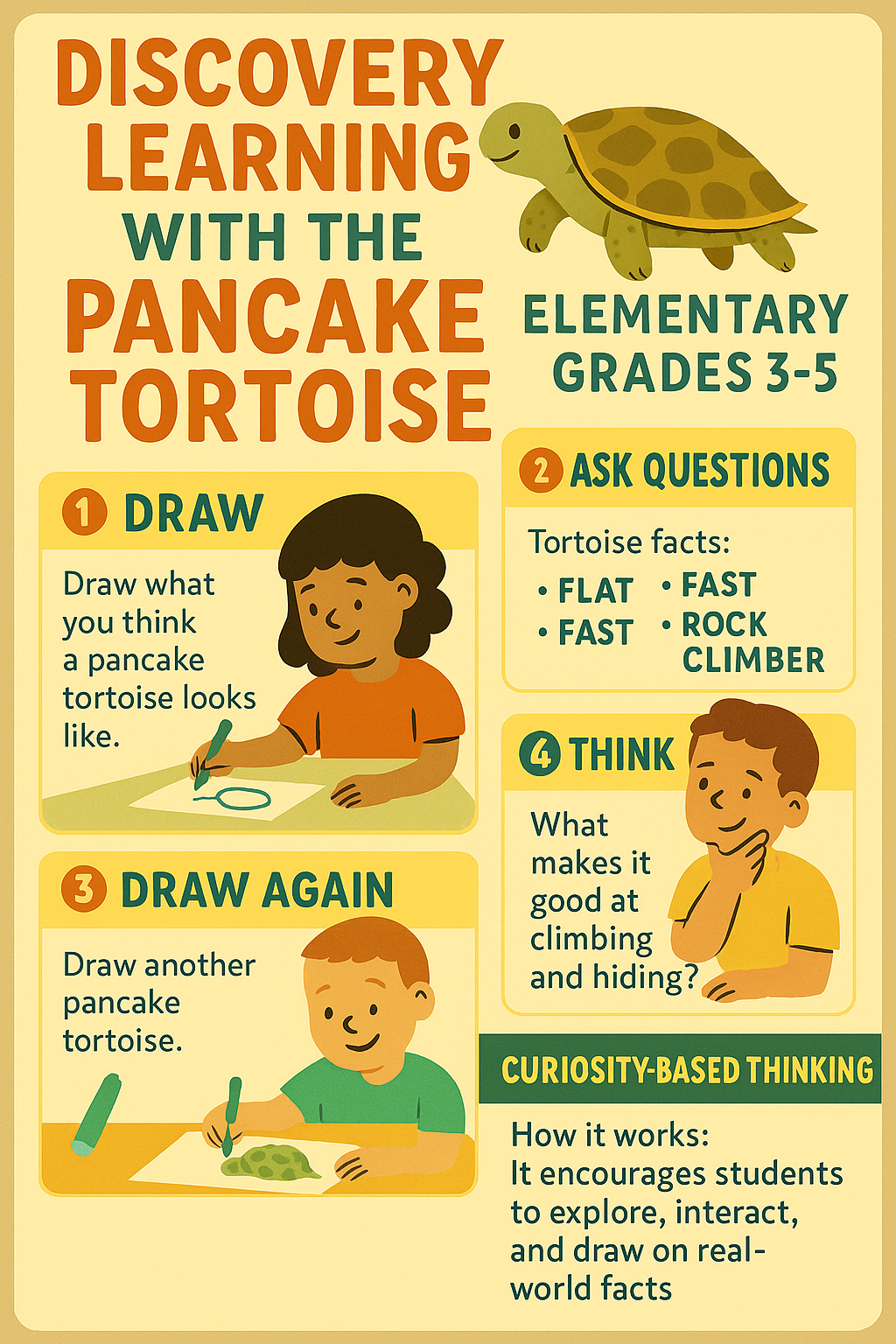From Pancake Tortoises to Problem Solvers
A Full Stack of 3 Curiosity-Based Thinking Activities for K–12 Classrooms
Flat Shells, Big Impact: How One Unusual Tortoise Can Transform Your Teaching
Hey you! Busy teacher!
You know who you are. You’re already juggling standards, schedules, and endless to-dos… but you still know all about the magic that happens when students are truly curious.
Did you know there’s a tortoise that can sprint almost as fast as you chasing your first coffee of the morning?
What if you could turn a quirky animal story into the highlight of your week’s lesson plan?
(Or even your entire week’s lesson plan?)
Meet the Pancake Tortoise, a flat-shelled marvel from The Screaming Hairy Armadillo, ready to dash into your classroom and spark some serious curiosity.

I’m stoked to combine some Curiosity-Based Thinking (CBT) with the Pancake Tortoise for you to help your students’ curiosity come out of their shells!
Wait! What is Curiosity-Based Thinking?
CBT is a simple, powerful way to make learning fun, effective, and repeatable, no matter how packed your schedule is.
CBT is all about tapping into that natural “what if?” energy kids (and let’s be honest, you) have.
It’s a four-step vibe: pique curiosity, dig into discovery, reframe what you know, and create something cool from it.
With the Pancake Tortoise as our curiosity animal, this article gives you four ready-to-roll activities—starting with one you can use today. Plus, each comes with tweaks for elementary (grades 3-5), middle (grades 6-8), and high (grades 9-12) students.
Let’s get curious!

1) Biomimicrosity with the Pancake Tortoise (Middle School - Grades 6-8)
Let’s kick things off with a quick, no-prep activity you can do right now. This one’s inspired by the CBT process, Biomimicrosity using the Pancake Tortoise to solve a classroom conundrum.
Objective: Students channel their curiosity about the Pancake Tortoise’s quirks to brainstorm fixes for everyday classroom hiccups.
Materials Needed:
Optional: A pic of the Pancake Tortoise (*For an extra layer of fun, ask your students to draw what they think a Pancake Tortoise looks like before you show them a picture.)
Paper, pens, or a whiteboard
Steps:
Introduce the Pancake Tortoise (5 minutes): Share these wild facts:
The Pancake Tortoise (Malacochersus tornieri) hails from Kenya and Tanzania’s rocky scrublands.
Its flat, flexible shell lets it squeeze into tight spots, it runs up to 5 mph (fast for a tortoise!), and its yellow-brown hues blend into rocks like a pro.
Spark Curiosity (5 minutes): Ask:
“What if you could solve a classroom problem like a Pancake Tortoise?”
“How would flattening yourself help?”
“Could camouflage make chaos disappear?”
Find more questions on the Screaming Hairy Armadillo Educator’s Guide
Pick a Problem (5 minutes): In small groups, students pick a classroom issue like lost pencils, noisy transitions, or desk clutter.
Brainstorm Solutions (10 minutes): Groups dream up fixes inspired by the tortoise’s traits. Maybe a “flat” pencil holder or a “camouflaged” quiet signal?
Share and Try (5 minutes): Each group pitches their idea; the class votes on one to test today.
Why It Works: This 30-minute burst hooks kids with a weird animal and turns gripes into giggles, all while flexing their problem-solving muscles.
Modifications:
Elementary (Grades 3-5): Focus on one trait (e.g., flatness). Kids draw how they’d use it to solve a simple issue (e.g., “I’d flatten to find my crayon!”) and share with a buddy.
High School (Grades 9-12): Go deeper—research the tortoise’s habitat and pitch a sustainable classroom fix (e.g., a flexible storage design) with a quick rationale.
Why Curiosity Matters in Education
Curiosity isn’t just a buzzword, it’s a game-changer. Research shows it’s like a brain booster shot: a University of California, Davis study found that piqued curiosity amps up memory for both the topic you’re amped to learn and random stuff you stumble across.
Another study links curiosity to better grades in reading and math for kindergartners.
For you?
It means engaged kids who dig deeper, making your day less about herding cats and more about guiding explorers. Plus, when they’re curious, you get to enjoy the ride too. That means less burnout, more high-fives, and tons of “oh, wow!” serendipitous moments.
2) Discovery Learning with the Pancake Tortoise (Elementary - Grades 3-5)
Ready for tomorrow? This one’s a tweak on the Discovery Learning CBT process. It’s a bit meatier—perfect for a two-day curiosity dive.
Objective: Kids imagine the Pancake Tortoise from a description, draw it, then compare it to the real deal, fueling wonder and questions.
Materials Needed:
Paper, crayons, or markers
Pancake Tortoise pics (print or project)
Steps:
Imagine It (10 minutes, Day 1): No pics yet! Say, “Picture a tortoise with a flat, pancake-like shell to hide in tiny spaces. It’s fast and climbs rocks!” Kids draw what they think it looks like.
Dig Deeper (10 minutes, Day 1): Share facts: It lives in rocky East Africa, eats plants, and wedges into crevices for safety. Kids ask questions—“Why’s it so fast?”—and jot or draw one thing they’re curious about.
Draw Again (10 minutes, Day 1): Share facts: It lives in rocky East Africa, eats plants, and wedges into crevices for safety. Kids ask questions—“Why’s it so fast?”—and jot or draw one thing they’re curious about.
Ask your students to draw a new picture using the new information they have.
Reveal and Compare (10 minutes, Day 2): Show real images. Chat about surprise, keeping your educator’s eye open for serendipitous learning opportunities. “Did you guess the flat shell?” or “What’s wilder than you thought?” or “How does what you draw connect to its name?”
Why It Works: Kids love guessing, then discovering. It’s a low-stress way to build observation skills and curiosity over two days.
Modifications:
Middle School (Grades 6-8): Add habitat details (e.g., dry scrublands). Kids write a short explanation of their drawing post-reveal, tying it to facts.
High School (Grades 9-12): Turn it scientific—hypothesize why its traits evolved, then research and present findings (e.g., “Flat shells beat predators!”).
How CBT Boosts Engagement and Satisfaction
CBT isn’t just fun—it’s backed by science. A comprehensive meta-analysis of 225 studies on active learning (think curiosity-driven methods like CBT) found that it significantly improves student performance and reduces failure rates compared to old school lectures.
Specifically, students in active learning environments scored about 6% higher on exams, and failure rates dropped from 33.8% to 21.8%.
Why?
Kids take the wheel, chasing what intrigues them. For you, that means a classroom buzzing with energy, not snores. Teachers using student-led methods like this also report loving their gigs more. That translates to less “sage on the stage” and more “guide on the side” for you.
3) Curiosity A-Z of the Pancake Tortoise (High School - Grades 9-12)
Got a week or a unit to play with? This CBT activity, Curiosity A-Z, is your multi-day masterpiece, perfect for a biology or conservation project.
Objective: Students craft an A-Z guide on the Pancake Tortoise, diving into its world and flexing research chops.
Materials Needed:
Research access (library, internet)
Paper, art supplies, or digital tools
Steps:
Launch It (Day 1, 20 minutes): Explain the Curiosity A-Z process: each student or group tackles the letters of the alphabet, finding one Pancake Tortoise fact (e.g., A: Adaptations, B: Behavior) and question they have about it related to that fact (e.g. A: What adaptation does it share with other turtles? B: What if it couldn’t run so fast?) Show an example.
Research (Days 2-3, 1-2 hours): Kids hunt facts—its speed, shell, or threats (it’s vulnerable due to pet trade!). Each letter gets a paragraph and an image/sketch.
Create (Days 4-5, 1-2 hours): Compile entries into a class book or slideshow. Think “F: Flexibility” with a drawing of it squeezing into rocks.
Share (Day 6, 30 minutes): Groups present their letters—class votes on fave insights.
Why It Works: It’s a deep dive that blends curiosity, ownership, and creativity—ideal for a unit capstone.
Modifications:
Elementary (Grades 3-5): Create one, Class Book. Each kid does one letter with a sentence and drawing (e.g., “S: Speedy!”).
Middle School (Grades 6-8): Pairs tackle 2-3 letters, writing short blurbs and adding pics for a poster.
Why Curiosity and CBT Rock Teaching
Curiosity turns classrooms into adventure hubs. It hooks kids, boosts memory, and makes learning stick. CBT gives you a playbook to channel that energy—pique, discover, reframe, create—making lessons pop and kids shine.
Studies show curious students thrive? You get a front-row seat to their “aha!” moments, making teaching less grind, more joy. It’s education with a pulse.
Curiosity Corner for Teachers
Need a quick pick-me-up? Try this anytime, solo or at your next PD:
Step 1: Jot one thing you’re curious about in your teaching—like a new trick or a pesky challenge.
Step 2: Share it with a colleague (or your coffee mug).
Step 3: Pick one tiny step to explore it. Read a blog, test a tweak, chat it up.
It’s a fast, fun way to keep your curiosity buzzing.
Stay Curious, Super Teachers!
Curiosity is your not-so-secret weapon. Light it up, and watch your classroom turn into a wonder zone.
These Pancake Tortoise adventures are just the start. Got ideas or want more? Hit me up! I’m all ears when it comes to curiosity wins.
Keep asking “what if?” and make learning the wild ride it should be.
Stay curious,
Matt Murrie









